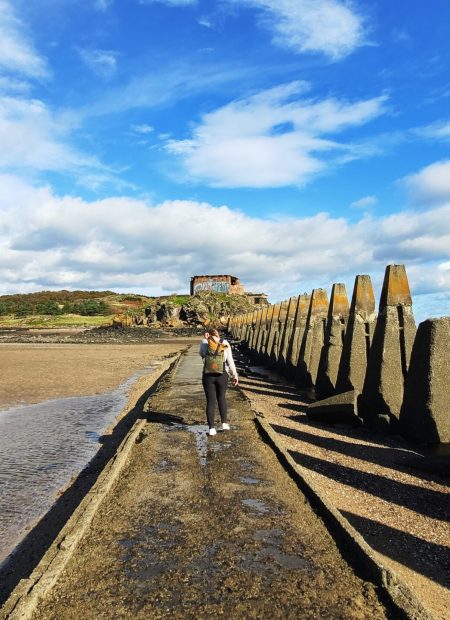
The best Iceland DIY winter golden circle itinerary [2024]
Whether you’re visiting for a few days, or a few weeks, the Golden Circle route offers a perfect introduction to Iceland. This DIY winter golden circle itinerary is a self-driving itinerary optimised for those short winter days! You’ll get to experience a taste of everything Iceland has to offer: geysers, hot springs, waterfalls, volcanic craters, and stunning scenery on the drives between.
We aim to get you away from the tourist route, without compromising on the must-do activities. So, keep reading for the only DIY winter golden circle itinerary you’ll need!
ABOUT THE GOLDEN CIRCLE
Close to Reykjavik, the Golden Circle is Iceland’s most popular tourist route. Its three main highlights are:
- Gulfoss (the ‘Golden Waterfall’)
- Þingvellir National Park, Iceland’s only UNESCO World Heritage Site on the mainland
- Haukadalur Geothermal Valley, where you can visit hot springs and geysers.
This DIY winter golden circle itinerary is carefully crafted for you to get the most out of your trip to Iceland. Yes, we’ll include Gulfoss, Þingvellir National Park, and Strokkur Geyser. But we want to nudge you slightly away from the tourist trail and show you the ‘real Iceland’ as well.
We’ve also created this itinerary with the short winter days in mind! Based on the route we took during our February trip to Iceland, we’ll ensure that you get the most out of those precious hours of winter sunlight! Oh, and we’ll provide free options and paid alternatives, so that you can make the most of your budget too.
Note: This can be done as a 1-day itinerary (choose your activities) or a 2-day itinerary (with time for all the activities) to suit your time, budget, and interests.
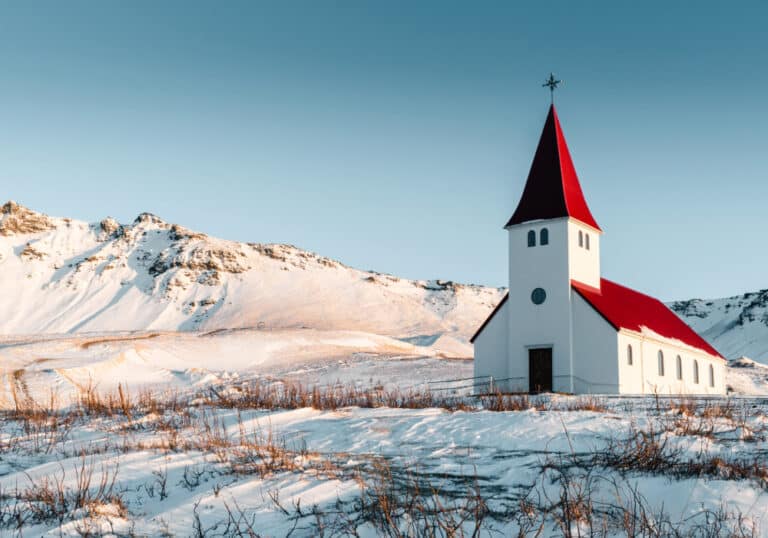
Iceland in Winter
WHY VISIT ICELAND IN WINTER?
#1 IT’S CHEAPER TO TRAVEL TO ICELAND IN WINTER
Winter is considered the off-peak season in Iceland. But this can help you save money. Accommodation can be half the price or less than in the summer, and some tour companies offer special off-season discount.
We found prices for accommodation in Iceland in winter on a par with hotels and self-catering flats here in Scotland. It wasn’t ‘budget’, but it was much cheaper than we were expecting from such a notoriously expensive country!
#2 THERE ARE UNIQUE ACTIVITIES TO ENJOY IN WINTER IN ICELAND
Yes, everything slows down a little, and lots of accommodation, activities, and restaurants close for the season. But there are unique adventures only to be found in winter, such as dog sledding, snowmobiling, glacier hiking, ice caving, and chasing the elusive Northern Lights. Winter doesn’t mean you can’t get back to nature either. You just need to be prepared with lots of layers, waterproof boots, and a pair of microspikes.
I can highly recommend visiting Iceland in late winter (February or March). We visited Iceland in early February. The sunsets were gorgeous and the pink skies lasted for hours. The the days were just about long enough to pack in everything we wanted to do. And the weather was perfect – crisp, cold and clear.
#3 THERE ARE FEWER CROWDS
We wrote this DIY winter golden circle itinerary to nudge you off the main tourist trail, without compromising on the key sites.
Why, you ask? Well, Iceland, which became a popular tourist destination after the 2010 eruption of the Eyjafjallajökull volcano, suffers from extreme overtourism. In 2023, over 2 million tourists visited Iceland, That’s 5.6 times the number of people who live there! This many people puts pressure on the main tourist sites, damaging ecosystems and natural habitats. We can protect these areas by spreading our tourism away from the main sites.
Visiting in winter is the first step to reducing your footprint. Winter tends to see fewer visitors compared to the peak summer months. This means you can explore popular attractions like the Golden Circle, the Blue Lagoon, and the South Coast without the crowds, allowing for a more intimate and immersive experience. You’ll also be helping spread the negative impact of tourism, allowing these environments time to recover.

The famous Icelandic Pony
KNOW BEFORE YOU GO…
This itinerary makes some assumptions! Here’s what we recommend:
1. BRING YOUR OWN CAR
To get off the beaten track a little, you’re going to need your own wheels! Because it’s winter, we really recommend hiring a car with four wheel drive and winter tyres. The main roads are fine, but the side roads definitely aren’t!
Having your own car will put you in complete control of your own itinerary. You can spend as little or as long as you like in all of the places we recommend. And who knows, you might even discover some of Iceland’s hidden gems for yourself?
Note: This itinerary assumes that you’re setting off from Reykjavik. To get a head start, you can stay the night before in Hveragerði or Selfoss. Both of these offer reasonably-priced accommodation and all of the amenities you’d expect from a town (gas station, supermarket, etc)
2. PACK A PICNIC
There are a few places to eat on the Golden Circle route, but we thought these were overly touristic and crazy busy. They also know tour buses stop there, and inflate the prices, which in an already expensive country… well, it isn’t fun.
We recommend bringing your own picnic. This will help you save time, money, and be more in control about when and where you stop. Hit the budget supermarkets of Iceland – Nettó, Bónus, or Krónan – to support the economy without breaking the bank. Then, pack a flask of tea or hot chocolate, and you should be good to go!
If you do want to grab food on the go, Þingvellir National Park and Gulfoss Waterfall both have a small café and gift shop. Strokkur Geyser has two restaurants, free bathrooms, and a huge gift shop. However, this is where every tour bus will stop at lunch time, so it gets busy!
3. BE PREPARED FOR WINTER CONDITIONS
If you want to get the most out of this DIY winter golden circle itinerary, you need to be prepared! We recommend bringing, at minimum, a waterproof jacket, waterproof trousers, good hiking boots, and microspikes.
Microspikes are really important if you enjoy generally not falling over all the time. We met someone who had slipped out of a minibus and broken their arm! This night not have happened if they’d had grippier footwear. A lot of blog posts will tell you that microspikes aren’t necessary for winter in Iceland, but we were so glad we’d brought them.
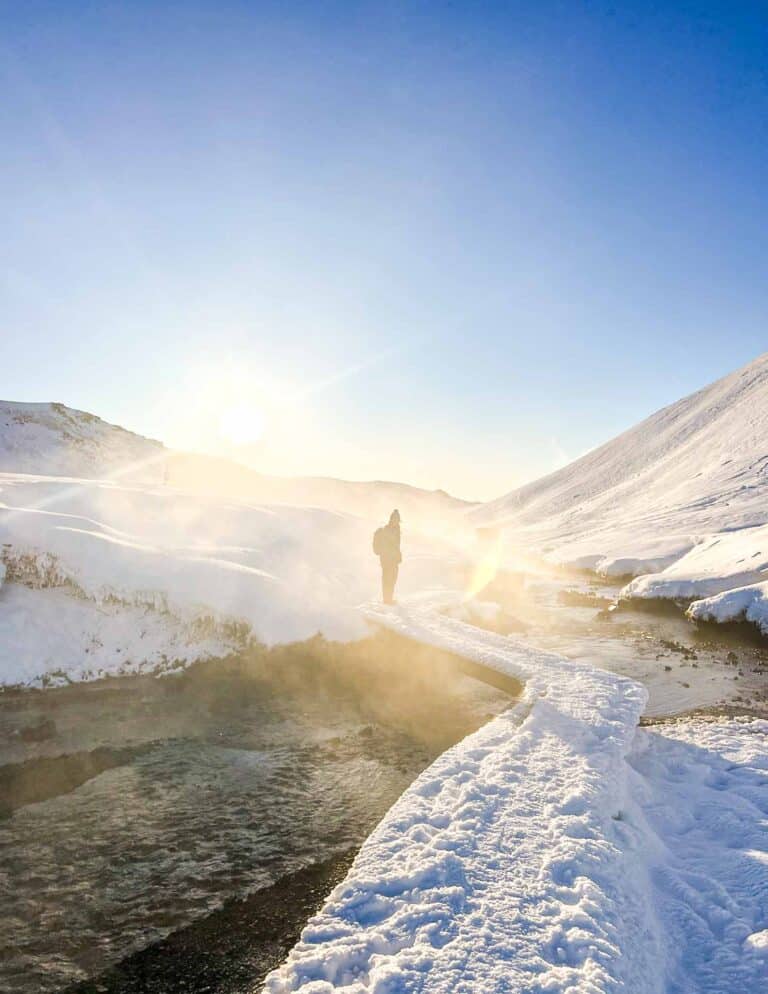
Reykjaladur Hot Springs Hike
YOUR DIY WINTER GOLDEN CIRCLE ITINERARY
#1(A) Hike to Hveragerði Hot Springs
Begin your day with an adventure by hiking to the Reykjadalur Hot Springs. Hiking and bathing in this toasty warm natural hot river is the perfect way to kickstart your DIY Winter Golden Circle Itinerary. Oh, and unlike the Blue Lagoon, bathing in Reykjadalur Hot Springs is 100% natural and 100% free!
If you want to add this optional 3 to 4 hour hike to take a dip in Reykjadalur free natural hot springs you’ll have to wake up before dawn… which in winter isn’t actually that early. Set off early from your accommodation in Reykjavik to arrive at the Hveragerði Hot Springs Hike car park by 9am latest. If you’re staying overnight in Hveragerði or Selfoss, the drive will be much shorter
Although this hot spring is a bit of a ‘hidden gem’, especially in winter, some tour buses do drop groups off to do this hike. But they usually don’t reach the trailhead until at least 10am. Starting early will give you plenty of time to enjoy the gorgeous winter scenery. It’ll also almost guarantee that you have the whole hot springs to yourself for at least 30 mins. We bathed for almost an hour and didn’t see other people until we were on the hike back.
Cost: 250 ISK/hour parking (total cost, 1000 ISK for a 4-hour hike)
#1(B) Explore Þingvellir National Park
Not up for an early start? That’s ok. Vacation is meant to be relaxing, and there’ll be more options to visit a hot spring later in this itinerary.
If you don’t want to get up for the Reykjadalur Hot Springs hike, head straight from your accommodation in Reykjavik to the nearby Þingvellir National Park. Þingvellir National Park is one of three UNESCO World Heritage sites in Iceland. And it’s truly magical. Dried magma fields carpeted in Icelandic moss sit by crystal clear glacier springs. Surrounded by waterfalls cascading from ancient mountain peaks, Þingvellir makes for a stop on the Golden Circle that’s hard to beat.
You can spend as little or as long as you like here. If you’re short on time, we’d recommend at the bare minimum, stopping off at the main visitor centre for ~30 minutes. Not only is the view unparalleled, but you can walk between the tectonic plate walls, and visit the crystal-clear Silfra Fissure.
If you have the time to spend, we recommend diving or snorkelling in the Silfra Fissure. Dive.is is the only company that offers diving, many offer snorkelling. This underwater rift is the only place in the world where you can dive or snorkel directly in a crack between two tectonic plates. Although there isn’t much in the way of wildlife, the visibility is incredible. And if you’re lucky and the sun is shining, you’ll get to watch the rays send rainbows dancing across the stone.
Cost: 1000 ISK per vehicle for unlimited parking around Þingvellir National Park
CUSTOMISE IT: TWO-DAY ITINERARY. If you have more time to enjoy the area of Iceland, you can combine the Reykjadalur hot springs hike with a visit to Þingvellir (Day 1) and stay overnight in Hveragerði or Selfoss. Then, you can continue with the rest of the itinerary on Day 2.
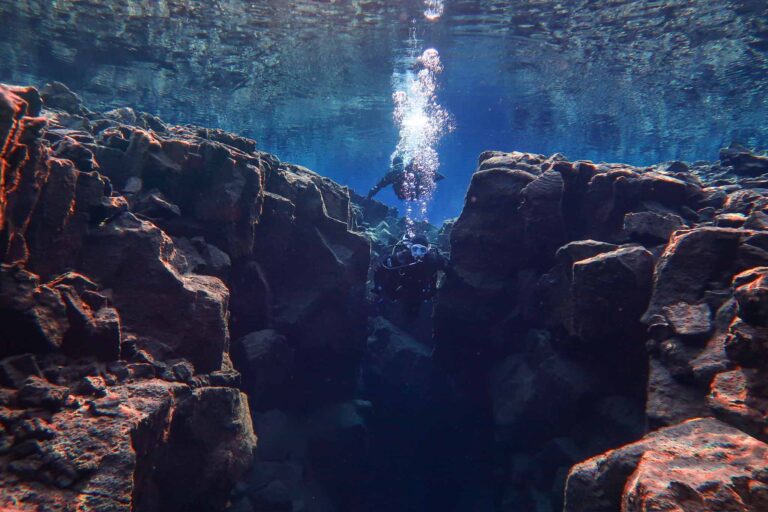
Diving in the Silfra Fissure
#2 Walk the circumference of Kerið Crater
If you started at Reykjadalur, your next stop will be the Kerið Crater. From Hveragerði or Reykjadalur Hot Springs, it’s a 15-minute drive (10 kilometres, 6 miles).
Scientists believe that Kerið was once a cone-shaped volcano. When it erupted, it is thought that the volcano collapsed into itself to form the crater we see today. At approximately 55 metres (180 feet) deep, 170 metres (558 feet) wide and 270 metres around.
In the summer, the crater is coloured in shades of mineral-red and grass-green, with a turquoise-blue lake at the bottom. You won’t be able to see this in the winter – the lake will be frozen and snow-covered – but it’s beautiful all the same.
We recommend that you spend ~30 minutes here. Take the path right to the crater’s edge, fully encircle it, and then drop down to the frozen lake.
If you started at Þingvellir, don’t worry! You can hit Kerið on the way back to Reykjavik, at the end of this itinerary.
Cost: 500 ISK per person
#3 Discover Brúarfoss
Time to get away from the tourist crowds again! Next on this DIY winter golden circle itinerary is Brúarfoss.
Brúarfoss, meaning ‘bridge waterfall’, was named for a stone archway that once crossed the river. That arch is long gone but the name remains. Brúarfoss is fed by the Brúará River, which originates at the Langjökull glacier. This glacial water is what gives the waterfall its beautiful blue colour. In fact, Brúarfoss has been named Iceland’s bluest waterfall.
One of the best things about this stop is that you can spend as little or as long as you like here. If you’re short on time (or daylight), you can park in the brand new Brúarfoss parking [opened April 2023]. From here, it is only a 5-minute walk to Brúarfoss – a real-time saver!
There’s also a short and easy 7km (4.4 miles) out-and-back hike. Following the Brúará River, you’ll also be able to visit several smaller waterfalls along the trail. The Brúará Trail Parking is just off the road, and is free. The trail is well-worn and easy to follow, even in the snow. However, as with all winter hikes, we’d recommend having microspikes and/or walking poles to help keep you steady.
We think Brúarfoss is worth the visit, especially if you love waterfalls, or if you are looking to catch your breath away from the Golden Circle crowds. It’s not Iceland’s most scenic walk or its most impressive waterfall, but it’s still a very enjoyable short hike.
Cost: 750 ISK (the new parking lot) or free (the roadside park and hike)
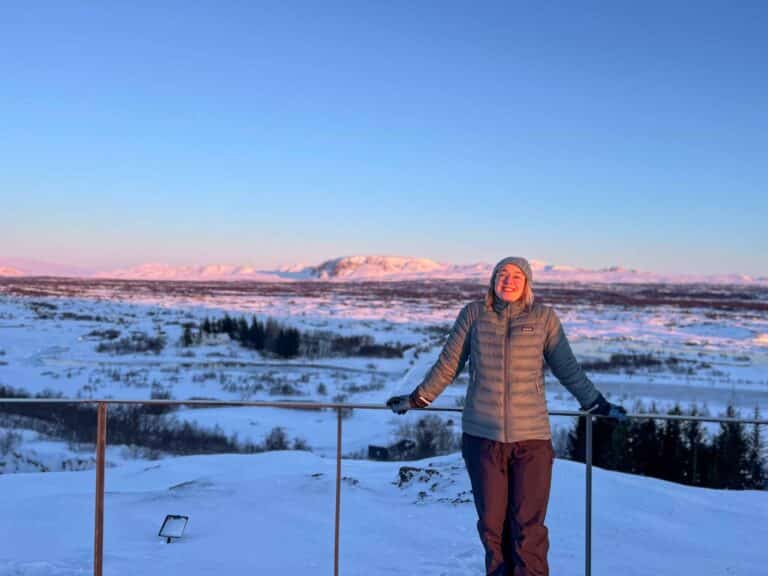
Exploring Þingvellir National Park
#4 Geysir and Strokkur
Ok, back to the main tourist trail! From Brúarfoss, drive ~15 minutes to the Geysir area. The Great Geysir, which lent its name to geysers worldwide, may be the biggest. But it’s Strokkur, Iceland’s most visited active geyser, that is the main attraction here.
Geysir itself is in a period of inactivity. It used to be fairly common to pump soap into the vents, which made the eruptions more dramatic. But this damaged the structure of the geyser and prevented the water build-up needed for large eruptions.
Strokkur erupts more regularly than Geysir ever did, blasting water to heights of around ten to twenty metres ~8 minutes or so. Despite being incredibly touristy, we still think Strokkur is pretty cool, especially if you’ve never seen a geyser before. That said, we don’t recommend spending too much time here. Thirty minutes is plenty to walk around and see Strokkur erupt a few times.
Top tip: Most tour buses aim to stop here around lunchtime. There are a lot of food options, but it’s very busy between 12-1pm.
Cost: 100% Free. No cost to park or use the facilities.
#5 Gulfoss Waterfall
A short 15-minute drive brings you to the majestic Gulfoss Waterfall. Gulfoss, which translates to ‘Golden Falls’, is one of Iceland’s most beloved and popular waterfalls.
Now, if you’ve timed this right, it should be approaching golden hour. Spend ~30 minutes admiring the colours of the setting sun reflecting on the cascading waters of one of Iceland’s most iconic landmarks.
Again, this is just a quick stop off. The waterfall is partly frozen over in the winter. The hiking trails aren’t accessible and you can’t get closer to the waterfall than the viewing platforms. But we think that it’s still worth a visit, especially as it doesn’t cost anything!
Cost: 100% Free. No cost to park or use the facilities.
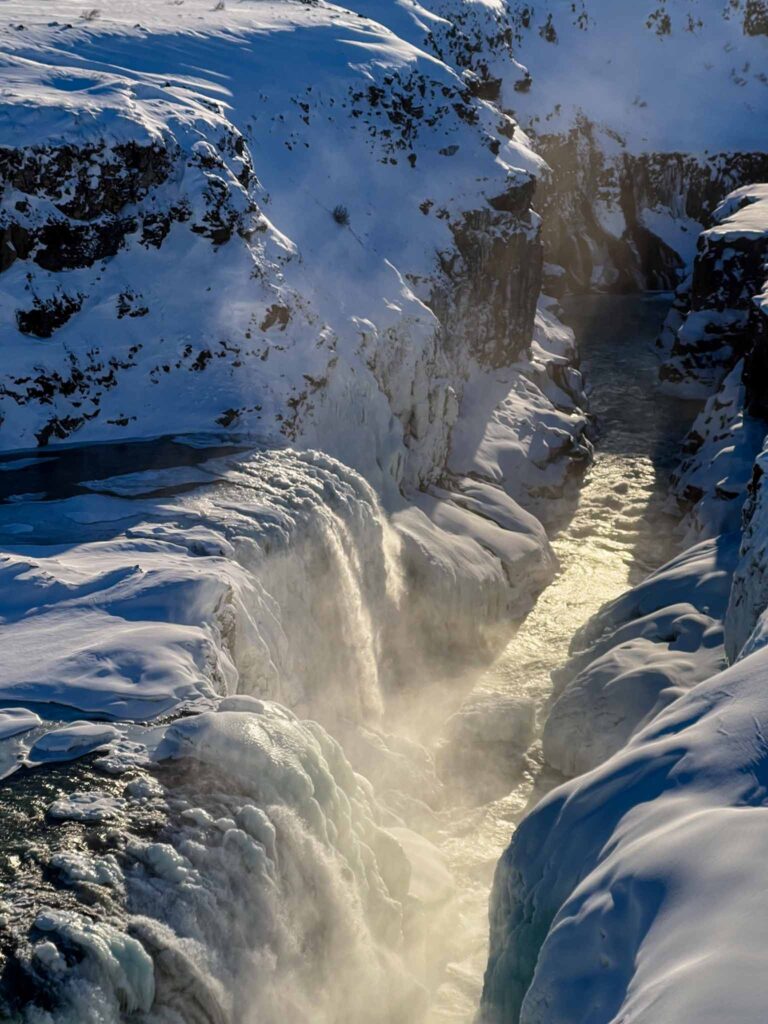
Gulfoss Waterfall from the viewpoint
Stop #6 [Optional] Unwind at Secret Lagoon
If you still have time left in the day, make a stop at the Secret Lagoon. Although it’s not really a ‘secret’ (it’s on Google Maps after all), we feel like this natural hot pool is a hidden gem, tucked away in an incredibly popular area. It’s well worth a visit.
The Secret Lagoon is located in Flúðir, a small village that you’ll pass through on the way back to Reykjavik. Surrounded by mossy lava fields, the lagoon is Iceland’s oldest swimming pool, and unlike some hot springs (looking at you, Reykjadalur and Hrunalaug), it’s deep enough to swim in! The deliciously warm and clear water is pumped in from a small geyser at the corner of the pool. This mini-geyser sends out little eruptions every 5 minutes or so, maintaining a temperature of 38-40° Celsius (100° Fahrenheit).
Compared to the Blue Lagoon, Secret Lagoon is an absolute bargain at around £22/$25 USD. The water is clear and naturally heated, unlike the blue lagoon, which is heated by a geothermal energy plant. Whilst the pool itself may feel very natural with its stone walls and mossy surround, the facilities inside are incredibly modern and clean.
We think that the Secret Lagoon is the perfect place to relax and unwind at the end of your DIY winter Golden Circle itinerary. There was no better way to end the day than enjoying the eternally long sunset while soaking in the soothing geothermal waters.
For a more natural and slightly cheaper experience you could head to the even more secret Hrunalaug Hot Springs (~£12/15 USD). This small local hot springs with its little rustic shepherd’s hut is a beautiful way to get back to nature. Although, like many of Iceland’s natural wonders, Hrunalaug has begun to suffer the negative effects of overtourism, with the site gaining popularity on social media.
Cost: 3600 ISK (around £22/$25 USD). You can find up-to-date costs and book tickets here.

Unwinding at Secret Lagoon for sunset
FINAL THOUGHTS:
And that’s it! It should be getting dark now, and it’s time to drive back to your accommodation. If you started your DIY winter Golden Circle Itinerary at Þingvellir National Park, you can check out the Kerið Crater on your way back to Reykjavik, Hveragerdi, or Selfoss.
We hope you enjoy exploring Iceland’s Golden Circle and that our DIY winter Golden Circle itinerary helps you to discover some less-popular but equally brilliant sites. So pack your bags, hit the road, and get ready to experience the magic of the Golden Circle firsthand!
If you liked this blog post, let us know below! We’d love to hear what you got up to on your DIY winter Golden Circle itinerary. Have a great trip!
LIKE IT? PIN IT!
SAVE THIS POST TO YOUR PINTEREST BOARD TO COME BACK LATER
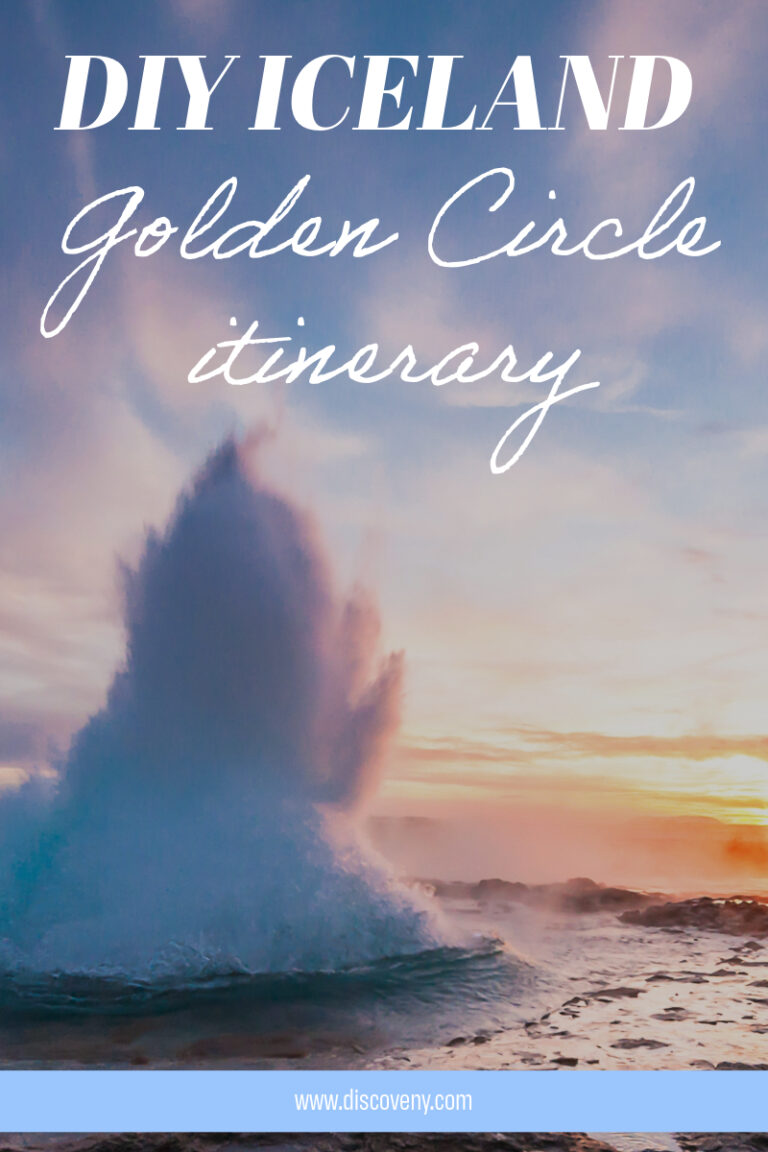
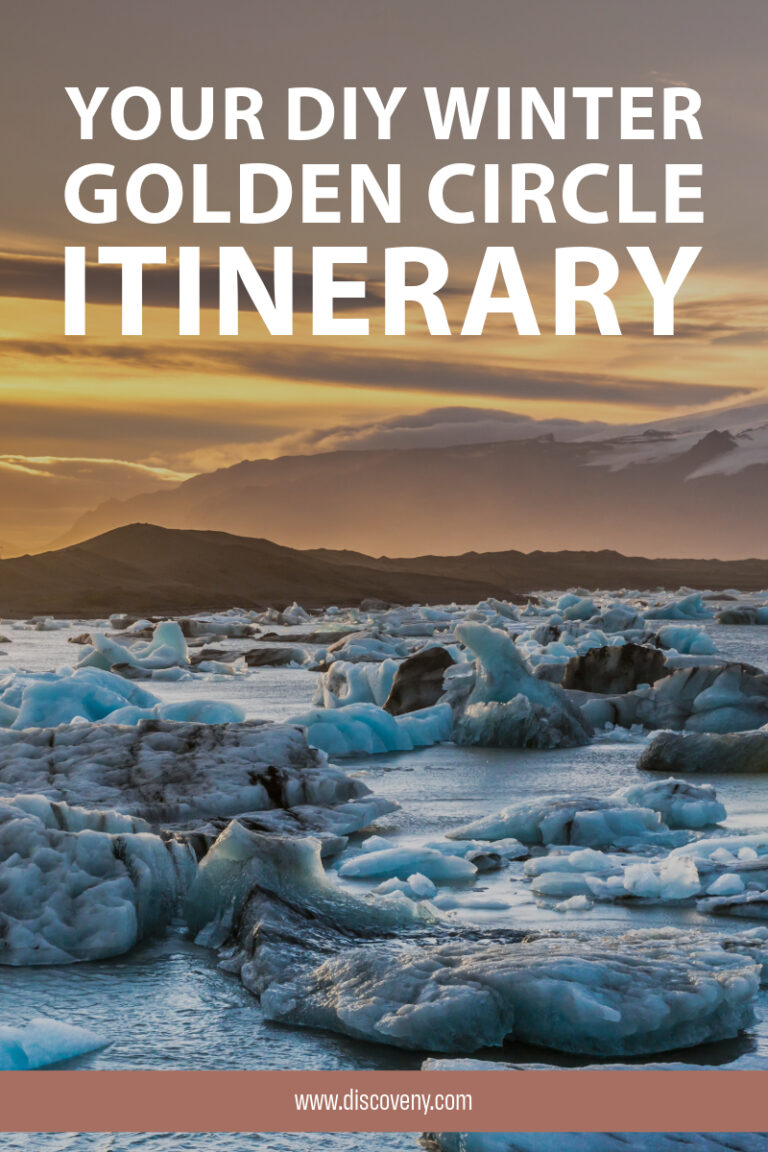
Follow our daily adventures on Facebook and Instagram
Disclaimer: The information and advice provided in this blog are the author’s opinions and based on their personal experiences. All information was accurate at the time of writing. However, things can change quickly, so always double-check current conditions and guidelines before setting out. Remember, your travels and safety are your own responsibility, and this blog can not be held responsible for anything that might happen on your adventures! Always exercise caution and good judgment. Oh, and don’t forget to get travel insurance! Happy travels!
This post may contain affiliate links (yay for transparency!) This means that I will earn a small commission, at no additional cost to you, if you click the link and choose to buy the product. I only link to stuff I have personally bought and found useful and never endorse crap. Your support helps keep the site going, thank you!
Alice
Alice is a UK travel blogger who advocates sustainable travel and being more eco-conscious on a budget. She loves coffee, her houseplants and summiting mountains.
You May Also Like
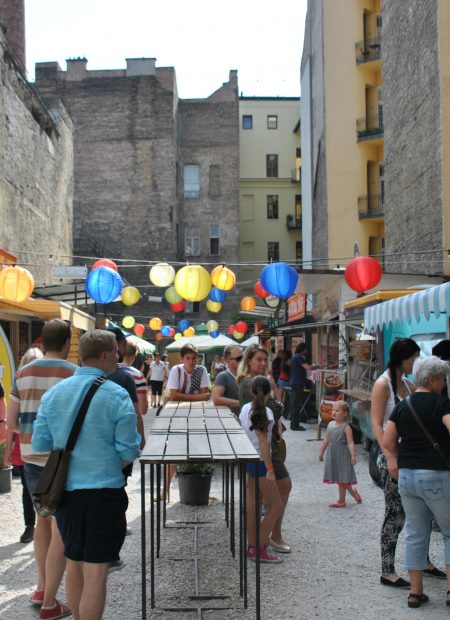
Hungry in Hungary: Your 2023 Guide to Veg-Friendly Hungarian Cuisine
January 7, 2023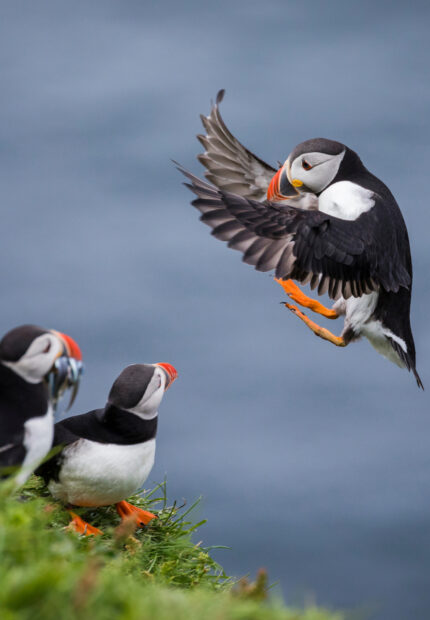
17 Best Places to see Puffins in Scotland
August 10, 2024